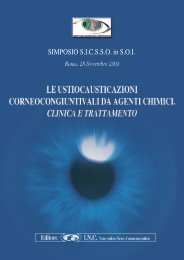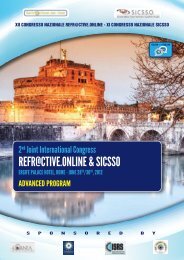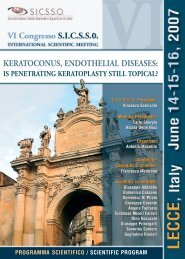1st EuCornea Congress
1st EuCornea Congress
1st EuCornea Congress
Create successful ePaper yourself
Turn your PDF publications into a flip-book with our unique Google optimized e-Paper software.
<strong>1st</strong> <strong>EuCornea</strong> <strong>Congress</strong> venice, 17-19 june 2010<br />
INVITED SPEAKERS<br />
communities and relevant bodies ‘ to make knowledge in the field of eye<br />
banking available to any person for the general good of society.<br />
ACTIVITIES: In the last 5 years the number of corneas received in EEBA<br />
member eye-banks was 33653(±5019) corneas. The overall percentage<br />
of corneas issued for transplantation was 54%. Most of the corneas were<br />
transplanted in the hospital housing the eye-bank or in the own country,<br />
whilst export to other countries was 7%. According to their activities,<br />
expressed as number of corneas issued per year, 34 European eye banks<br />
are issuing 100-500 corneas, 12 are issuing 50-100 and only 3 eye banks<br />
>1000 corneas per year. Of the received corneas 49% was retrieved<br />
by enucleation and 51% by corneosclearal disc excision. Organ-culture<br />
remains the preferred storage methods in EEBA (70% of preserved<br />
corneas). In recent years EEBA Technical guidelines have been developed<br />
and published describing selection criteria deemed acceptable for cornea<br />
evaluation. Of all corneas that were not selected for grafting, more than<br />
half was excluded because of morphology (16,3%) and other reasons were<br />
serology (11.5%), medical history (2,9%), microbiology (3,4%) and others.<br />
All banks test all donors for HIV Abs, Hepatitis B and C, either antigen,<br />
antibodies or both and most eye banks additionally test for syphilis. Mean<br />
frequency of positive serology ranges from 6-8.56% in the last 5 years. In<br />
2008, 13% of the corneas was selected and issued for lamellar grafting,<br />
and sometimes lamellar grafts were pretreated in the bank. Only a small<br />
proportion of the transplanted corneas were tissue-typed; typing for HLA<br />
1 was done for 15,2% of all donors and for HLA11 fro 12,3%. Adverse<br />
reactions (such as primary failures and endophthalmitis) occurred at 0.1<br />
and 0.01% risk. Of other tissues used for ocular surgery EEBA banks were<br />
issuing sclera, limbal graft, stem cells and amniotic membranes. “<br />
Dua, Harminder Singh<br />
Limbal niches and stem cells: is the paradigm changing<br />
H.S. Dua, A. Miri, D. Said<br />
University of Nottingham, Nottingham, UK<br />
A large body of clinical and laboratory evidence supports the notion that<br />
stem cells of the corneal epithelium reside at the corneoscleral limbus. They<br />
are slow cycling and constitute a small proportion of the total cell mass.<br />
Their progeny, termed transient amplifying cells (TAC), form the basal cells<br />
of the cornea and can proliferate and migrate rapidly in response to injury.<br />
Distinct anatomical structures, termed limbal epithelial crypts (LEC), have<br />
been demonstrated to extend as a solid cord of cells from the peripheral<br />
end of the interpalisade (of Vogt) body of epithelial cells. Morphological,<br />
immunohistochemical and molecular characterisation of the cells of<br />
the LEC strongly suggests that the LEC represents a niche for corneal<br />
epithelial stem cells. Damage to the limbus results in conjunctivalisation of<br />
the cornea, a hallmark of limbal stem cell deficiency and transplantation<br />
of the limbus helps restore normal corneal epithelial cover. We studied<br />
ten eyes of seven patients who presented with a central ‘island’ of normal<br />
epithelial cells surrounded with 360 degrees of limbal stem cell deficiency<br />
with conjunctivalization of the limbus and peripheral cornea. This was<br />
established by clinical features, in vivo confocal microscopy and impression<br />
cytology. The central islands of normal corneal epithelium survived over a<br />
follow up period of 1 to 12 years. Molecular characterisation of the central<br />
corneal epithelium of normal donor eyes revealed presence of several<br />
genes that are associated with stem cells in other organ systems. Other<br />
in-vitro studies on organ cultures human corneas and in-vivo transplant<br />
studies in beta galactosidase (blue) mice also strongly support the<br />
existence of progenitor cells in the central cornea. On the basis of the<br />
above observations we hypothesise that the limbus has a limited role to<br />
play in physiological homeostasis of the corneal epithelium, which can be<br />
sustained by the basal cells of the central cornea. However following insult<br />
or injury, the limbal stem cells have an important role in corneal epithelial<br />
regeneration. It is likely that the transition from stem cells to TAC occurs via<br />
a hierarchy of progenitor cells, which we have termed ‘transient cells’. It is<br />
likely that the central cornea is populated with such transient cells.<br />
El Danasoury, Alaa<br />
Deep lamellar keratoplasty with the big bubble & a<br />
femtosecond laser (iDALK)<br />
A El Danasoury<br />
Saudi Arabia<br />
Purpose: Reporting outcomes of the first 24 cases of DALK with baring<br />
of Descemet’s membrane using Femtosecond laser (Intralase) and big<br />
bubble technique.<br />
Methods: 24 eyes with advanced keratoconus had DALK; Intralase was<br />
used to create mushroom shaped trephinations for donors and recipients;<br />
big air bubble to separate recipients’ Descemet’s membrane from stroma.<br />
Donor button was secured with 12 bytes 10/0 running suture.<br />
Results: At 6 months (follow up; 91.6%), 83.3% eyes saw 20/40 or better<br />
with correction; mean cylinder was 3.61 ± 1.24 D. No vision-threatening<br />
complications were encountered.<br />
Conclusion: Femtosecond laser trephination can be combined with big<br />
bubble technique to expose Descemet’s membrane with good refractive<br />
outcome. Larger series and longer follow-up are needed.<br />
Fogla, Rajesh<br />
Modified instrumentation to simplify the big bubble<br />
technique of DALK surgery<br />
R. Fogla<br />
Hyderabad, India<br />
Big Bubble technique of deep anterior lamellar keratoplasty (DALK) helps<br />
retain the healthy host endothelium with good visual outcome. The original<br />
technique using a 27G needle is difficult to master, and often frustrating to<br />
the learning surgeon. Newer instruments designed to simplify the technique<br />
will be presented. With these instrument the Big Bubble separation of<br />
Descemet Membrane from stroma is achieved more consistently. These<br />
instruments simplify the learning curve making it easier for the corneal<br />
surgeon to adopt Big Bubble technique of DALK surgery in their practice.<br />
Gatzioufas, Zisis<br />
Effect of thyroxine on corneal biomechanics<br />
Zi Gatzioufas 1 , P. Charalambous 1 , V. Kozobolis 2 , B. Seitz 1<br />
1. Department of Ophthalmology, University of Saarland, Homburg/Saar Germany<br />
2. Department of Ophthalmology, Democritus University of Thrace Thrace Greece<br />
Background/Aim: Our research group has documented that normal<br />
human cornea expresses thyroxine receptors (THR). Keratoconus is<br />
characterized by differential THR expression in basal epithelial layer and<br />
anterior stroma. Aim of our study was to investigate the impact of thyroxine<br />
(T4) on corneal biomechanics.<br />
Methods: We examined 16 patients with hypothyroidism, 12 patients<br />
with hyperthyroidism and/or endocrine orbitopathy and 18 normal subjects<br />
by means of Ocular Response Analyzer and estimated the corneal<br />
hysteresis (mean value±SD, mm Hg). Fourteen rabbit corneas were<br />
cultivated for 10 days in organ culture (medium I) with and without T4 of<br />
0.02 mM concentration (2.5 ng/dL) and afterwards the stress-strain curve<br />
for each cornea was determined with the aid of a biomaterial tester (mean<br />
value±SD, Pa). Young’s modulus E was also calculated. Corneal thickness<br />
was measured using ultrasound pachymetry (mean value±SD, µm). Cell<br />
cultures of rabbit corneal epithelial cells were established and the epithelial<br />
cell proliferation rate in cultures with or without T4 treatment was evaluated.<br />
Student’s t-test was used for statistical analysis in all experiments. P values<br />
< 0.05 were considered statistically significant.<br />
Results: Corneal hysteresis in patients with hyperthyroidism (14.1±2.4)<br />
was significantly increased compared to patients with hypothyroidism<br />
(9.8±2.5) and normal subjects (10.4±2.3) (p0.05, t-test). Stress values were compared at 10% strain.<br />
Mean stress value in corneas treated with T4 was 214±56 compared to<br />
31







